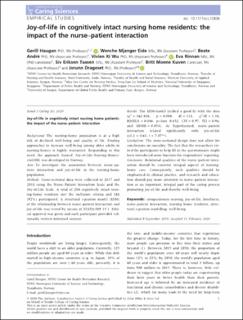| dc.contributor.author | Haugan, Gørill | |
| dc.contributor.author | Eide, Wenche Mjanger | |
| dc.contributor.author | Andre, Beate | |
| dc.contributor.author | Wu, Vivien Xi | |
| dc.contributor.author | Rinnan, Eva | |
| dc.contributor.author | Taasen, Siv Eriksen | |
| dc.contributor.author | Kuven, Britt Moene | |
| dc.contributor.author | Drageset, Jorunn | |
| dc.date.accessioned | 2020-07-06T09:29:45Z | |
| dc.date.available | 2020-07-06T09:29:45Z | |
| dc.date.created | 2020-02-11T17:07:26Z | |
| dc.date.issued | 2020 | |
| dc.identifier.citation | Haugan, G., Eide, W. M., Andre, B., Wu, V. X., Rinnan, E., Taasen, S. E., Kuven, B. M. & Drageset, J. (2020). Joy-of-life in cognitively intact nursing home patients: the impact of the nurse-patient interaction. Scandinavian Journal of Caring Sciences. doi: | en_US |
| dc.identifier.issn | 1471-6712 | |
| dc.identifier.uri | https://hdl.handle.net/11250/2660815 | |
| dc.description.abstract | Background
The nursing‐home population is at a high risk of declined well‐being and quality of life. Finding approaches to increase well‐being among older adults in nursing‐homes is highly warranted. Responding to this need, the approach framed ‘Joy‐of‐Life‐Nursing‐Homes’ (JoLNH) was developed in Norway.
Aim
To investigate the association between nurse–patient interaction and joy‐of‐life in the nursing‐home population.
Methods
Cross‐sectional data were collected in 2017 and 2018 using the Nurse–Patient Interaction Scale and the Joy‐of‐Life Scale. A total of 204 cognitively intact nursing‐home residents met the inclusion criteria and 188 (92%) participated. A structural equation model (SEM) of the relationship between nurse–patient interaction and joy‐of‐life was tested by means of STATA/MP 15.1. Ethical approval was given and each participant provided voluntarily written informed consent.
Results
The SEM‐model yielded a good fit with the data (χ2 = 162.418, p = 0.004, df = 118, χ2/df = 1.38, RMSEA = 0.046, p‐close 0.652, CFI = 0.97, TLI = 0.96, and SRMR = 0.054). As hypothesised, nurse–patient interaction related significantly with joy‐of‐life (γ1,1 = 0.61, t = 7.07**).
Limitations
The cross‐sectional design does not allow for conclusions on causality. The fact that the researchers visited the participants to help fill in the questionnaire might have introduced some bias into the respondents’ reporting.
Conclusion
Relational qualities of the nurse–patient interaction should be essential integral aspects of nursing‐home care. Consequently, such qualities should be emphasised in clinical practice, and research and education should pay more attention to nurse–patient interaction as an important, integral part of the caring process promoting joy‐of‐life and thereby well‐being. | en_US |
| dc.language.iso | eng | en_US |
| dc.publisher | Wiley | en_US |
| dc.relation.uri | https://onlinelibrary.wiley.com/doi/pdf/10.1111/scs.12836 | |
| dc.rights | Attribution-NonCommercial-NoDerivatives 4.0 Internasjonal | |
| dc.rights.uri | http://creativecommons.org/licenses/by-nc-nd/4.0/deed.no | |
| dc.title | Joy-of-life in cognitively intact nursing home patients : the impact of the nurse-patient interaction | en_US |
| dc.type | Peer reviewed | en_US |
| dc.type | Journal article | en_US |
| dc.description.version | publishedVersion | en_US |
| dc.rights.holder | © 2020 The Author(s) | en_US |
| dc.subject.nsi | VDP::Medisinske Fag: 700::Helsefag: 800 | en_US |
| dc.source.pagenumber | 12 | en_US |
| dc.source.journal | Scandinavian Journal of Caring Sciences | en_US |
| dc.identifier.doi | 10.1111/scs.12836 | |
| dc.identifier.cristin | 1793195 | |
| dc.relation.project | Norwegian Council of Research: 238331 | en_US |
| dc.description.localcode | Unit Licence Agreement | en_US |

